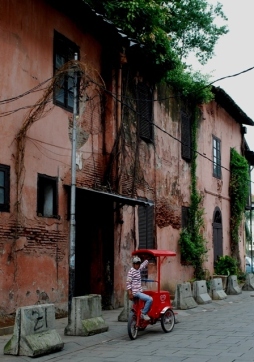 By the sea in North Jakarta, Batavia stands as a decaying and neglected reminder of Jakarta’s colonial past. Just a few disintegrating facades speak to the memory of Holland’s Queen in the East.
By the sea in North Jakarta, Batavia stands as a decaying and neglected reminder of Jakarta’s colonial past. Just a few disintegrating facades speak to the memory of Holland’s Queen in the East.
It was a city bought at a cost. Thousands perished on the treacherous journey from Europe. Hundreds died in its defence. In Holland, schoolyard tales of the fantastical colonial outpost gave way to night terrors as Batavia became known as The Graveyard of the Europeans.
The rich, colourful and often brutal history of the old town has been buried by years of inaction on the part of successive provincial governments and a generational, prophetic desire to forget the past and forge a new history for Indonesia.
For Ro King, Chairwoman of the Indonesian Heritage Society the way a nation moves forward is understanding how all the disparate parts of its past fit together. “There are negative parts and there are positive parts but understanding it is part of the whole mix.”
And Batavia is a mix. Cloves, pepper, nutmeg; the holy trinity of the Asian spice trade. Upon these, the fortunes of Java’s colonizers were first founded. And it was these that brought the Dutch to the archipelago.
Soon a great gathering of Europeans made their way to Batavia. Small armies of Dutchmen working as traders, bankers, surveyors, soldiers, farmers, engineers and tax collectors. All dedicated to the one unerring mission: making money.
So Batavia grew to great heights in the 17th and 18th centuries, only fall unspectacularly. Disease, corruption and war spelt the end of this place.
Now Batavia has little to offer visitors. When the famous Café Batavia opened 15 years ago it was the only commercial enterprise in the Batavia’s square, Taman Fatahillah. Fifteen years on, it still is. Graham James is the Australian owner who purchased the property in the early 90s. “After all that time, I’m the only one doing business here and I must say after that amount of time it does get a little lonely.”
In 1975 the Indonesian Government made Taman Fatahillah an Indonesian Heritage site. Looking at crumbling rooftops, broken pavestones and museums with water seeping through walls, one wonders how concerned Jakartans really are about this heritage.
Unlike other old-cities throughout Asia, Batavia has never had a development action plan. There are no building codes. Most of the property is owned by government which is somewhat unwilling to let them go. Even if they are rotting.
Efforts to preserve the area highlight the eclectic nature of the Indonesian bureaucratic nightmare. Four years ago a project was started to repave the entire square and surrounding alleyways.
With no consultation with locals the venture began. In 2007 it was completed. But instead of digging down and then repaving they built directly on top. “You see here,” says Ella, a businesswoman with property in Batavia. “See the stones are above the doors. Now they cannot even open them, and because the ground is higher than the door, these places all flood. They have to pump out the water.”
Jakarta’s colonial history has been, for the most part, swept under the carpet by an administration desperate to forget that the history of Jakarta was, for the most part, a Dutch one.
But now there could be some hope. The most recent mayor of West Jakarta has made it his private project to develop a long term plan for the area. Clean the greasy slow flowing canals. Renovate the buildings and consult with private business to make Batavia at least somewhat reminiscent of its former glory. The site is significant, even beautiful but it has lacked vision, verve and money.
With the failings of the past it is now with the younger generation where most of the hope lies.
Serrano Sianturi works for the Sacred Bridge Cultural Foundation. The organisation runs a program called “Hug the City” which takes school children to Old Batavia to learn and appreciate its history.
“Now it is time to defrost our history, to reclaim our culture. If we defrost it and really look at it, only then can we preserve it and learn from it better.”
